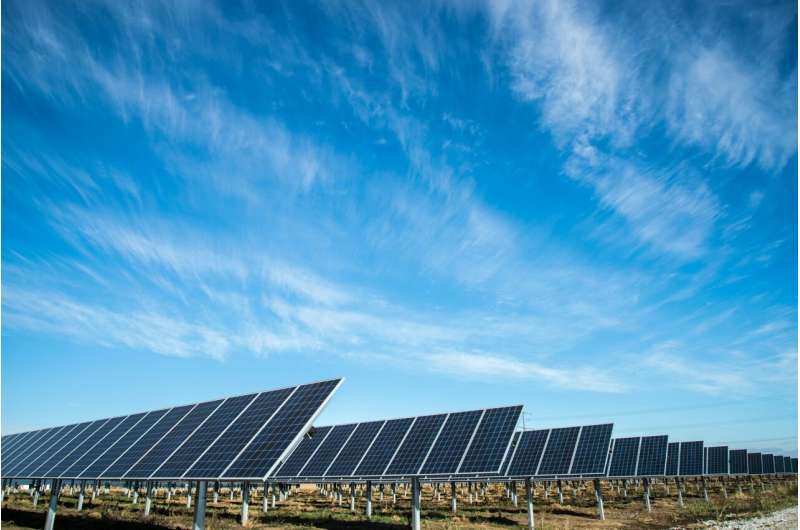
Would you like to live next door to a solar farm? Traditionally, it’s been thought that although people like the idea of renewable energy plants, they don’t want them close by. Now, research investigating how people who live near large-scale solar projects feel about them has found that 82% of people living within an hour’s walk of current projects would support, or are neutral toward, new projects in their area.
“Most neighbors of existing large-scale solar projects either support or feel neutral about additional projects in or near their communities, with only 18% opposing it,” said Dr. Sarah Mills of the University of Michigan, an author of an article in Frontiers in Sustainable Energy Policy.
“Just as has been documented for wind energy, we found that the NIMBY—not in my backyard—explanation for opposition to solar was overly simplistic and unhelpful in explaining neighbors’ sentiments.”
Not in my backyard?
The US already has more than 4,000 large-scale solar energy plants which can produce more than a megawatt of electricity each. Some studies suggest that the country could increase its solar capacity by up to 70 gigawatts a year in the next decade, which would mean building approximately 1,650 projects annually. But if this transition to green energy is going to work, we need to understand what impacts solar plants have on communities.
The scientists sent out surveys to people living within three miles of large-scale solar projects installed between 2017 and 2021, asking about their support levels for new solar projects, as well as their experience of living near an existing solar project. They ultimately received 979 responses, covering 379 different solar projects ranging in size from one to 328 megawatts across 39 states.
“Large-scale solar projects require approximately five to eight acres of land per MW,” said Mills. “The projects we studied were on average about 400 acres. But some were over 2,000 acres, or three square miles.”
Green light
Overall, 43% of respondents said they felt positively about their local solar project, 42% were neutral, and 15% felt negatively. This almost exactly matched the support levels for new solar projects: 43% would support new projects, 39% remained neutral, and 18% said they would oppose additional solar projects.
To explore the factors influencing this, the scientists created two models. The first focused only on objective variables, such as the date a project was installed. The second model also included subjective variables like the reported impact on quality of life.
Most of the variables in the objective model only weakly correlated with support: the most influential was the size of the existing project. Respondents living near large projects were less likely to support additional projects.
Subjective variables were much more strongly associated with support for additional solar projects, especially the perceived impact on community quality of life and aesthetics. There was one notable exception: residents who reported greater familiarity with the existing project were less likely to support a new one.
“We can’t be certain that more familiarity causes lower support for additional solar,” said Mills. “Rather, we find that more familiarity is correlated with lower support. Our hypothesis is that residents who see the project more regularly feel that their community already hosts their fair share of infrastructure.
“That said, most respondents rarely saw, or were totally unaware of, the project prior to receiving our survey. So it could be that most in the community are essentially unaffected, whereas a minority sees it frequently and does not wish to see more.”
A solar-powered future?
The researchers did find that many people living near solar projects seemed to be poorly informed about their local projects, suggesting that developers need to engage with locals more. But this research indicates that most people who live near solar projects are comfortable with their renewable energy neighbors.
These findings could help guide energy infrastructure development, informing how we manage new renewable energy plants for a greener future.
“This survey was really just one snapshot in time,” cautioned Mills, calling for more follow‐up research to understand how impacts on the community and local opinion change over time.
“We strongly encourage future work to conduct longitudinal social science research—for example, to collect data throughout the planning, development, construction, and operational phases of large-scale energy plants.”
More information:
More Power to Them: U.S. Large-Scale Solar Neighbors’ Support for Additional Solar, Frontiers in Sustainable Energy Policy (2025). DOI: 10.3389/fsuep.2025.1579170
Citation:
‘Yes, in my back yard’—most people who live near large-scale solar projects are happy to have more built nearby (2025, June 17)
retrieved 17 June 2025
from
This document is subject to copyright. Apart from any fair dealing for the purpose of private study or research, no
part may be reproduced without the written permission. The content is provided for information purposes only.













Leave a comment